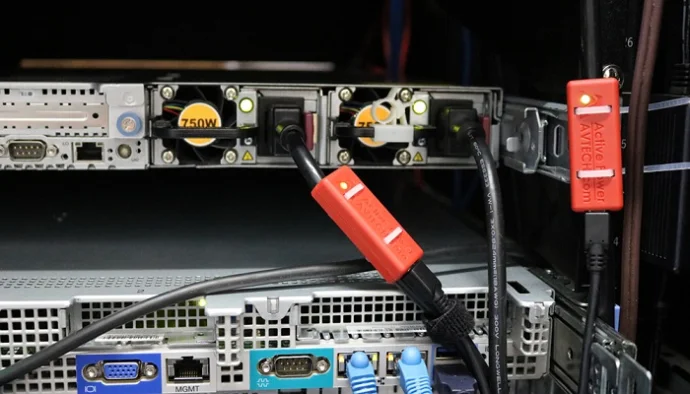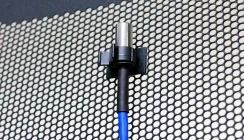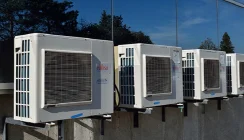How to Use Server Room Monitoring and Control Systems
Temperature levels within racks, server room or datacentre environment are one of the most important environmental factors to regularly monitor. Sudden room temperature rises can indicate the failure of a critical infrastructure system such as an air conditioner and lead to server failures and worst case a fire starting. Hot-spots within server racks can literally ‘cook’ the electronics and batteries within in-rack UPS systems. Low temperatures can be a sign that the cooling system operating parameters are set too low, leading to excess energy usage and higher operating costs.
What Does A Server Room Environmental Monitoring System Do?
Server room environmental monitoring systems range in sophistication from simple data loggers to device that can be accessed via an internet connection. Essentially the system comprises of an environment monitor, a sensor (which may be built-in or plugged-in) and a monitoring software package. The principle features of an environmental monitoring system include:
- Data Measurement: measurements are taken at pre-set time periods from the sensors, detectors or probes built-into the environment monitor or plugged-into it. The most common in a server room or datacentre facility are temperature or temperature/humidity. Others include smoke and fire, flood and water leakage, airflow and air pressure and access control and motion.
- Alarms and Alert Notifications: each monitoring parameter has a pre-set alarm threshold. When this is exceeded an alarm or alert notification is triggered. This can be audible, visual (LED/strobe light) or issued via email, SMS text message or SNMP over an IP/Ethernet connection or a notification to a mobile application.
- Data Analysis: the measured data is captured and can be analysed for trends or investigated when an alarm is raised.
In addition to monitoring and analysis, events can be also be used to trigger automatic actions using digital outputs (DO) to initiate actuators or other devices.
A Single Pane of Glass View
For small IT closets and server installations, the local IT manager may rely on temperature sensors built-into installed systems i.e. uninterruptible power supplies (UPS), air conditioners, servers and storage devices. Internal temperature and sometimes fan-failure monitoring may be built-into these devices with optional plug-in sensors for assemblies including external UPS battery packs.
Each of these critical items will likely generate an alarm if they see an internal temperature above a pre-set threshold. Temperature-related alarms can indicate the failure of a cooling fan in a UPS system or a pump failure within an air conditioning system. The alarm may be audible, visual, reported remotely using SNMP over an IP network or relay signal contact.
Other infrastructure systems including rack-level power distribution units (PDUs) may also offer additional monitoring sensor points. Some intelligent PDUs can be installed with plug-in temperature and access control sensors. The information they collate can include temperature readings within a server rack and ON/OFF (open or closed) states for rack doors. The information and state changes are reported to the manufacturer specific monitoring software package over an IP network or via SNMP to third-party platforms.
The main weakness in this approach to temperature monitoring is that it does not provide a single ‘pain of glass’ view but a disparate one that may be split across several monitoring programs. Whilst the use of a data centre infrastructure management (DCIM) package could overcome this, for most server room and small-to-medium sized datacentre operators, the cost of DCIM implementation can be prohibitive.
When it comes to IT closets, computer and server rooms and small-to-medium sized datacentres with a smaller number of server racks, a dedicated server room monitoring, and control system is the most widely adopted solution. These types of system centre around a combination of hardware-based environment monitors, plug-in sensors, detectors and converters and a master-station type monitoring package that may be hosted on a local server or Cloud-based facility.
Data Logging and Recording
There can be several drivers for monitoring environments. Within the food and pharmaceutical manufacturing industries, there may be legislative or insurance requirements that can only be met by a comprehensive environmental monitoring system.
In the IT industry, from small IT closets to server rooms and datacentres, the drivers may be more operational. The higher the power demand of a server, the greater the need to monitor ambient temperature and heat loads placed onto local cooling systems. When temperatures rise quickly, especially within a server rack, reliability can be compromised and there is a potential for thermal runaway in the rack, especially those with higher power demands (15-30kW). Energy efficiency and electricity usage are other metrics affected by room temperatures.
There are three ways to record and access environment-related data:
- Standalone Data Loggers: these are standalone devices that are put in-situ and are used to take readings on a regular basis for later analysis. This is one of the simplest methods with which to log server room environmental factors including temperature and humidity. The data logger may incorporate a front panel LCD to display a monitored parameter and may be able to alarm audibly or show the alarm on the LCD panel. The data must be manually downloaded onto a USB flash drive, laptop or PC periodically for analysis. The data logger will have a record limit (typically up to 2,500 to 3,000 records) and is reset each time the data is downloaded. There are several problems with this type of data logging system. Firstly, data can be missed if the record buffer is not cleared and too long is taken between downloads. Secondly, alarms/alerts can be missed as the device cannot be remotely monitored and thirdly, the recorded data is not backed-up or automatically available over a network or hybrid-Cloud system.
- Ethernet Connected Environment Monitors: typically devices with IP Ethernet, WiFi or GSM connectivity for the automatic monitoring and recording of environmental parameters including temperature or temperature and humidity. Some environment monitors have the facility to add further sensors or detectors for a range of environmental factors including smoke/fire, water/leakage, airflow/pressure and access control. Environment monitors automatically take readings at pre-set intervals and report this to master-station type software. This type of monitor can be used to record environmental information over several points within a server rack or at several server room locations to provide a more comprehensive overview than can be achieved with data loggers. This is a more sophisticated device than a data logger, but the additional cost can be more than offset by savings in visiting sites to download data and the more comprehensive overview provided. The data is backed-up by the network archiving system.
- Cloud-based Portal Connected Environment Monitors: accessed via any browser supporting HTTPS, a cloud-based portal provides instant and remote access to any of the environment monitors connected to the portal. The monitoring devices may be connected to the internet portal via IP Ethernet or WiFi with information available in ‘real-time’ in addition to the stored. Data can also be download onto a PC, laptop or tablet for off-line analysis. A Cloud-based system provides data backup and access to historical data. If the connected devices lose internet connection, they may store their data locally (as a data logger) and then upload the data when the web-connection is restored.
A basic data logger may only be capable of monitoring one or possible two environmental aspects i.e. temperature or temperature and humidity. Automatic and cloud-based environment monitors may be able to monitor a wider range of digital inputs (DI) and analog readings using additional plug-in sensors and detectors.
Built-in Temperature Sensors v Plug-in Detectors
An environmental monitoring system consists out of three main elements: a base unit or hub, probes or sensors, and network connectivity and integration. The hubs may contain one or more built-in sensors, as well as ports for hooking up external probes. They also include an Ethernet port and have software for remote configuration and graphing. This software may also work with existing network management software, such as SNMP systems.
For complete server room monitoring and control a dedicated environment monitoring system should be installed. This will comprise an environment monitor, along with a set of sensors (temperature only, temperature and humidity, water and leaks etc, detectors (smoke and security), converters (to monitor generator fuel tank levels or air flow) and monitoring software.
Room and Rack Level Temperature Monitoring
When selecting a server room monitoring system one of the first things to identify is what needs to be monitored and where. It is important to consider both the room and rack levels and especially as the IT facility increases in size from a single rack to several racks or rows.
Server Room Level Monitoring
The recommended temperature for a server room is 18-27degC with a relative humidity (RH) of 40-60% and Dew Point temperature at 60% RH of 5.5degC. These are targets for the complete room but due to layout and equipment configuration there could be ‘hot-zones’ into which temperature sensors should be placed. ‘Hot-zones’ can be identified using a thermal imaging camera.
More information on temperature and humidity level recommendations in a server room:
https://www.cisco.com/c/en/us/solutions/collateral/data-center-virtualization/unified-computing/white_paper_c11-680202.html
Individual air conditioning units in the server room may or may not be monitored over a local IP/Ethernet connection, mobile application or building management system. Temperature sensors should be placed near to local air conditioners to get ‘failure’ detection as early as possible and provide an additional layer of security. This can be more important where there are multiple AC units installed, as the running units compensate for a failed unit.
Humidity monitoring is also important. If the relative humidity is too high, there can be a build-up of static electricity. Too humid and condensation can build-up leading to corrosion and the potential for a short-circuit condition.
In larger facilities it may be necessary to monitor the temperature and humidity levels within and outside hot/cold aisle containment areas.
Rack Level Temperature Monitoring
ASHRAE is often referred to for guidance on server room temperature and humidity levels. The organisation recommends from six sensors per rack at the top, middle and bottom of a rack in pairs for the front and rear of the sections. Front and rear monitoring is important as cool air is drawn into the rack from 18degC and expelled to the rear at no less than 20degC.
The principle reason for rack level temperature monitoring is the power drawn by typical racks which can quickly lead to a ‘hot-spot’ and especially if a local air conditioner fails. High internal rack temperatures place greater workloads on server fan assemblies and can lead to CPU level data processing errors and potentially heat-induced stress failures.
The sensors do not have to use fixed wires. Wireless sensors can be an option for larger server room and datacentre facilities and are cheaper to install and reconfigure. The wireless approach also reduces the need for IP connections on the local network.
Other sensors to consider at a room level include smoke/fire, water/leakage, airflow/pressure and access control including motion sensing IP cameras.
Summary
Temperature and humidity monitoring will continue to grow in importance to organisations reliant on their on-premise service rooms and internet connectivity. The use of a server room environmental management system not only helps with capacity planning and energy efficiency. It can also help an IT or facility manager to respond to a sudden temperature rise and prevent a catastrophic system failure. In addition, climate change is also placing an extra cooling burden on many installed air conditioning systems and real-time monitoring can identify when to bring in additional cooling or upgrade an existing air conditioning system.


























